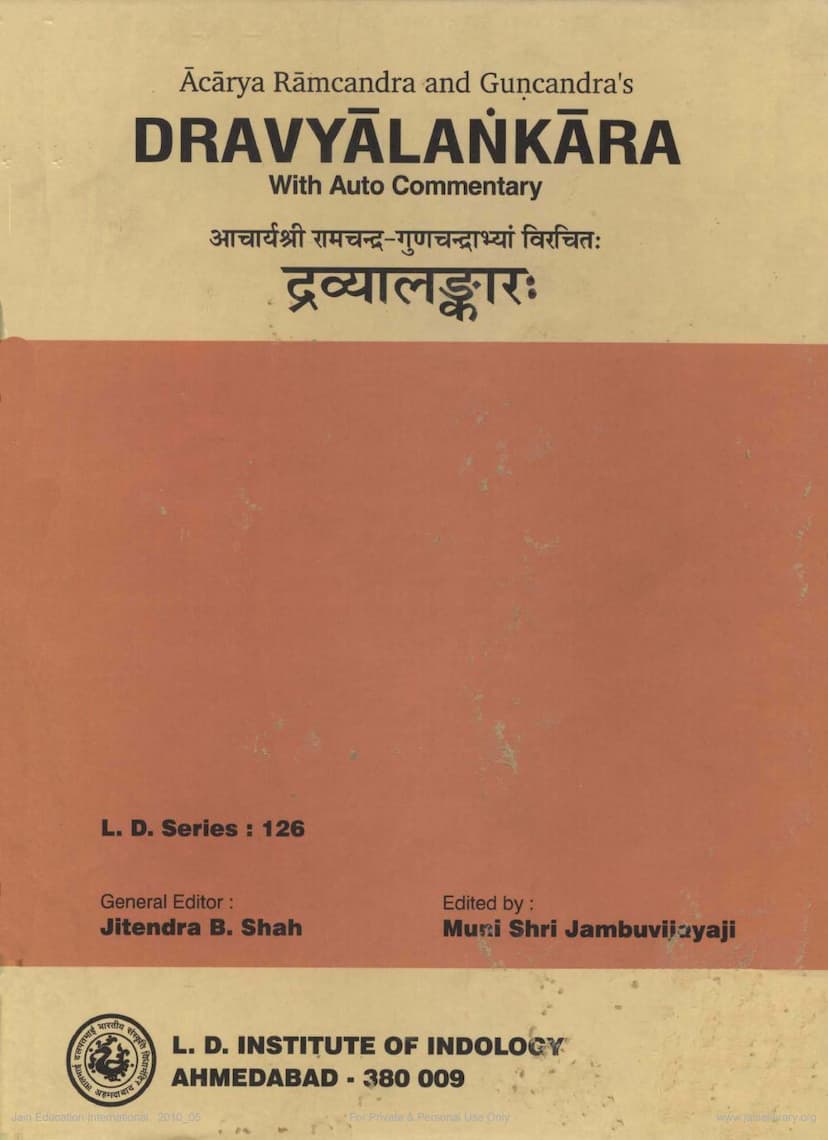Dravyalankara
Added to library: September 1, 2025

Summary
Based on the provided text, here is a comprehensive summary of the Jain text "Dravyalankara" by Acharyas Ramchandra and Gunchandra:
Book Title: Dravyalankara Author(s): Acharya Ramchandra, Acharya Gunchandra Publisher: L. D. Institute of Indology, Ahmedabad L. D. Series: 126 Editor: Muni Shri Jambuvijayaji First Edition: June, 2001 ISBN: 81-85857-08-3 Price: Rs. 290
Overall Summary:
Dravyalankara is a significant philosophical work by Acharyas Ramchandra and Gunchandra, who were renowned disciples of the great Acharya Hemachandra. The text focuses on a systematic philosophical exposition of the six fundamental substances (dravyas) accepted in Jain philosophy. It is notable for being the only known Jain work that elaborates on these substances from a philosophical perspective, a subject not extensively covered in other Jain Agamic texts.
Key Features and Content:
-
Authorship and Lineage: Acharyas Ramchandra and Gunchandra were prominent disciples of the illustrious Acharya Hemachandra Suri, the "Kālikālavijña" (Omniscient of the Age). Their works, particularly their dramas, are highly acclaimed for their literary merit. Dravyalankara is considered their sole philosophical treatise.
-
Structure and Scope: The work is divided into three "Prakāshas" (sections or chapters):
- Prathama Jiva Prakash (First Section on the Soul): This section provides an extensive and detailed philosophical discussion on the Soul (Jiva), its nature, characteristics, and classifications. It delves into discussions on the soul from a Jain perspective, critically examining and refuting the views of other philosophical schools like Charvaka, Bauddha, and Vaisheshika on the nature of the soul.
- Dwitiya Pudgala Prakash (Second Section on Matter): This section focuses on the substance of Matter (Pudgala), detailing its various forms, characteristics, the concept of atoms (paramanu) and aggregates (skandhas), and the principles of transformation (parinama). Similar to the first section, it engages in critical analysis of non-Jain philosophical viewpoints.
- Tritiya Akampa Prakash (Third Section on the Immovable): This section deals with the remaining three substances that are considered "immovable" or "immaterial" in a sense: Dharma (Medium of Motion), Adharma (Medium of Rest), and Akasha (Space). It also includes discussions on Kala (Time) and its unique nature. The text explains their fundamental principles, functions, and existence from the Jain perspective, again offering refutations of opposing philosophical doctrines.
-
Auto-Commentary (Sva-upajña Ṭīkā): The authors themselves provided a commentary on the Dravyalankara. The published edition includes this auto-commentary, which is crucial for understanding the concise and often abstruse nature of the original text. The commentary for the second and third sections is available, while the commentary for the first section is unfortunately lost or unavailable.
-
Originality and Contribution: Dravyalankara is unique in the Jain tradition for its in-depth philosophical treatment of the six Dravyas. Acharyas Ramchandra and Gunchandra initiated this approach, presenting the substances, their classifications, and their characteristics in a systematic philosophical manner.
-
Critical Engagement with Other Schools: A significant aspect of the Dravyalankara and its commentary is the detailed refutation of the philosophical tenets of other Indian schools of thought (Jain-etara Darshanas). The authors extensively quote from and critique the original texts of these schools, providing valuable historical and philosophical information for scholars interested in comparative studies of Indian philosophies. The text is particularly noted for its engagement with Buddhist philosophical concepts, including the refutation of nihilistic and momentary theories.
-
Language and Style: The original text is composed in a sutra-like style, making the commentary indispensable for comprehension. The commentary itself is detailed and elaborates on the principles, often citing extensive passages from various philosophical and literary works of the time.
-
Manuscript Tradition: The current edition is based on the available manuscripts. The auto-commentary for the second and third sections is derived from a palm-leaf manuscript written in VS 1202 (1145 CE) found in the Jinbhadra Suri Grantha Bhandara in Jaisalmer. The original text of Dravyalankara, covering all three sections, is available in a paper manuscript from VS 1492 (1435 CE) located in Ahmedabad. The editor, Muni Shri Jambuvijayaji, meticulously researched and collated these manuscripts to produce the published edition. The introduction highlights the difficulty in finding the complete commentary, especially for the first section, and acknowledges the richness of information that would have been available had it been preserved.
-
Significance for Scholarship: The Dravyalankara is a valuable resource for scholars of Jainism and Indian philosophy. Its detailed analysis of the Dravyas, its engagement with opposing philosophical viewpoints, and its extensive use of quotations from other philosophical works make it a cornerstone for understanding the intellectual climate of medieval India and the philosophical depth of Jainism. The text also provides insights into Sanskrit literature and the history of Buddhist philosophy through its critiques.
In essence, Dravyalankara stands as a monumental work in Jain philosophy, offering a comprehensive and critical examination of the fundamental substances of existence from a uniquely Jain perspective, enriched by the insightful auto-commentary of its learned authors.